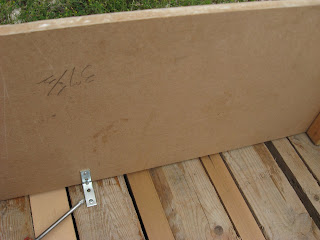 View of the empty Toronto lot (and future home of
View of the empty Toronto lot (and future home of
my 24sq ft urban farm) from my loft windowI have eight weeks to plant, grow, harvest, and sell the produce from my 24 sq ft 'urban farm' while, at the same time, I will design, test, prototype and present the Urban Farm Cart Project. This project stems from an assignment in one of my graduate design studio courses. The project continues because I did not reach a meaningful solution to this design problem by the end of the semester. I realized that I need to get my hands dirty, literally, and totally immerse myself in the process of urban farming in order to create a product/system that is as functional, desirable and beautiful as I think it can and should be.
The objective of the Urban Farm Cart Project is to create a product with an embedded system which allows the user, or urban farmer, to plant, grow, harvest, and sell produce in an urban environment. As oil prices continue to increase and with it the price of food, coupled with concerns about the safety of our food, there are serious questions about the future viability of our current food system. As a result, people are looking to the age old tradition of growing their own food, regardless of the amount of arable land they have. Postage stamp sized yards, empty city lots, rooftops, fire escapes, window sills, are becoming viable green space. The idea of using these spaces to plant is not new. Urbanites have resourcefully used these small spaces to bring a bit of nature into their city lives for a long time, but seeing these spaces as opportunities for supporting an urban agricultural economy is still catching on. Out of necessity, these spaces will increasingly support our nutritional needs and create economic opportunity.
My goal is to design an urban farm cart that will assist farmers through the entire growing process, season to season, providing a means to store and transport tools, supplies, and produce at one end of the process while also allowing for a fluid financial and social exchange at the other end. While there are thousands of products on the market for gardeners, farmers, vendors in the form of carts, wagons, green houses, grow boxes, electric tools, hand tools, 'time-saving' gadgets, etc., I have not found one product designed specifically for urban farming -- one that covers the many facets and needs in a succinct, meaningful way. If there was such a product, I would have bought it already and would be using it to grow my garden.
I've set a few rules for myself as I begin delving into this design problem. As I start my diminutive urban farm, I am trying to reuse materials. I am limiting my budget and will use the money I do spend to purchase from locally owned businesses as much as I can. As I am trying to design a product that will transport materials and produce and do so with minimal reliance on fossil fuels, I am trying not to use the car where at all possible.
At the end of the eight weeks, my goal is to have a functional prototype and some produce. I plan to use my prototype cart to harvest, transport and sell my produce at one of the local farmers' markets. Here I want to talk with people about the project and get feedback about it. I will be also sharing the results of the project with other urban farmers and with my professors, fellow designers, classmates, family and friends.

 I mentioned previously that there is alot of debris in the empty lot, left over from the factory that used to be there. As such there are always interesting things to find on the ground, including rusty rebar and thin strips of metal. These metal objects have a much nicer effect on the fence behind the garden than lying on the ground.
I mentioned previously that there is alot of debris in the empty lot, left over from the factory that used to be there. As such there are always interesting things to find on the ground, including rusty rebar and thin strips of metal. These metal objects have a much nicer effect on the fence behind the garden than lying on the ground.




























